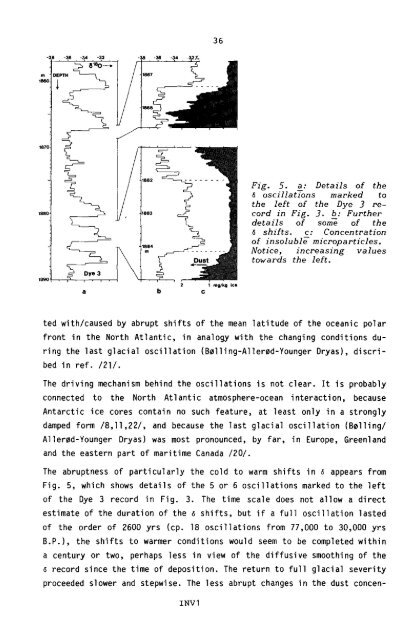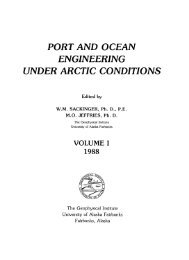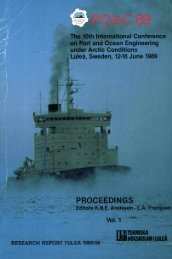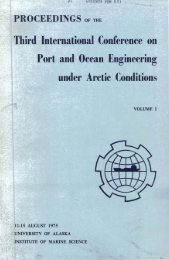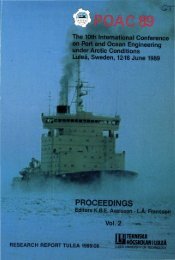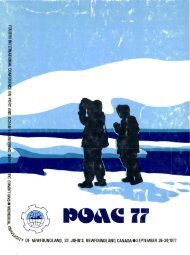- Page 2 and 3: @POAC85 .JAN 8 '86 The 8th internat
- Page 4 and 5: TABLE OF CONTENTS (summary): VOLUME
- Page 6 and 7: iii A7 Rexford, M.M. INVESTIGATION
- Page 8 and 9: C5 Wheeler, J.D., SEA ICE GOUGE STA
- Page 10 and 11: vii F15 To, N.M. A METHOD OF CALCUL
- Page 12: ix TOPIC K - TOPICS UNIQUE TO THE G
- Page 15 and 16: 2 tures in the Arctic, but the impo
- Page 17 and 18: INTERNATIONAL COMMITTEE President:
- Page 20 and 21: Mr. P. Christiansen Monberg & Thors
- Page 24 and 25: Bigum & Steenfos Consulting Enginee
- Page 27 and 28: P.E. Ehrhardt A/S Smedeland 28 P.O.
- Page 29 and 30: 16 Mr. B. Parsons National Research
- Page 31: Mr. J. Dietrich Danish Hydraulic In
- Page 35 and 36: Mr. J. Hoikkanen W§rtsila/W.A.R.C.
- Page 37: 24 Mr. T. Kawasaki Mitsubishi Heavy
- Page 40 and 41: Mr. R. Colony University of Washing
- Page 42: 29 INVITED LECTURES
- Page 45 and 46: North • Site North Central Su'!"m
- Page 47: 10 20 30 40 50 60 70 80 90 100 110
- Page 52 and 53: lations is doubtful, because the si
- Page 59 and 60: 46 Louis REY Member of the Internat
- Page 61 and 62: 48 considerations which can readily
- Page 63 and 64: 50 do impact seriously on men, inte
- Page 65 and 66: 52 as culture and environment but a
- Page 67 and 68: 54 structural sensitivity of the in
- Page 69 and 70: 56 Is it not, indeed, the privilege
- Page 71 and 72: 58 1. REY, L., ed., The Arctic Ocea
- Page 73 and 74: 60 F. Rainer Engelhardt, Director B
- Page 75 and 76: 62 environment. Direct interference
- Page 77 and 78: 64 It has been determined that the
- Page 79 and 80: 66 An additional concern over impac
- Page 81: 3 CONCLUSIONS 68 An increasing leve
- Page 84: 71 physical modelling is necessary
- Page 88: 75 Lennart Fransson, Lie. Eng. Divi
- Page 91: 78 pressure factors. The cohesion w
- Page 95: 82 50 100 150 200 250 DIAMETER (mm)
- Page 98:
SHEA. (') 2000 1000 85 1000 2000 IC
- Page 101:
J.B. Johnson G.F.N. Cox W.B. Tucker
- Page 104 and 105:
91 Fig. 3. Ice conditions around CR
- Page 107:
Fig. 6. 94 Vertical variation of ic
- Page 111 and 112:
to the west of the panel, and our l
- Page 113:
100 4. COX, G.F.N.; JOHNSON, J.B.;
- Page 120:
} 10 7 Fig . 7. Horizontal layers (
- Page 124 and 125:
111 that the island had gouged the
- Page 126:
11 3 a . Viewed from the north. b.
- Page 129:
116 Austin Kovacs, Research Civil E
- Page 136:
123 At ridge 8 vertical and horizon
- Page 139 and 140:
126 struct an axial double-ball loa
- Page 141:
128 B.L. Parsons Institute for Mari
- Page 145:
132 In the configuration of Fig. 2b
- Page 148 and 149:
\ 135 10) Timco, G.W., Flexural Str
- Page 151:
E.A. Pulkkinen, researcher Universi
- Page 155 and 156:
A 4 3 1 1 11112£\ 2 142 Figure 1.
- Page 157:
144 the material properties accordi
- Page 161:
148 boundary 6 can be stiff or free
- Page 173:
o 4 8 10 Depth 4 4 8 o 16 0 40 Dist
- Page 190 and 191:
177 W.B. Tucker III, A.J. Gow and W
- Page 192 and 193:
Fig. 1. Ice core sampling locations
- Page 197:
184 ice thickness for both ice type
- Page 200 and 201:
187 The ice salinities measured her
- Page 202 and 203:
189 Wang Renshu,Liu Xushi, Zhang Li
- Page 208:
M. Yamashita M. Katayama Y. Taguchi
- Page 216 and 217:
203 mate the crack initiation load
- Page 218 and 219:
205 TOPIC B ARCTIC OCEANOGRAPHY AND
- Page 221 and 222:
208 small sill fjord Affarlikassaa
- Page 228 and 229:
215 In autumn the vertical diffusio
- Page 231:
218 retention time for metals and f
- Page 242 and 243:
229 REFERENCES 1. Walsh. J.E. and C
- Page 244:
231 2.000 km 2 = 2 x 10 6 km 2 •
- Page 248 and 249:
235 plex. An oceanographic model th
- Page 250 and 251:
237 p p (S,T) (12) SYSTEM 3 is a ge
- Page 253 and 254:
Initial Conditions Atmospheric Mode
- Page 255:
242 In the design of fixed offshore
- Page 263 and 264:
The Concept of Reference Frame 250
- Page 265:
252 reference time for the velocity
- Page 271 and 272:
-1300 -1400 -1500 -1600 • -1700
- Page 273:
260 Reimer, R., Pritchard, R. and C
- Page 281 and 282:
268 Inside the failure envelope it
- Page 294 and 295:
281 /2/ ADAMS, E.E. and WELLS, S.A.
- Page 296 and 297:
283 V.R. Neralla and S. Venkatesh A
- Page 299 and 300:
2.3 Sea Ice Data 286 2.3.1 Aircraft
- Page 301 and 302:
2.4 Buoy Data 288 Buoys were deploy
- Page 303:
4 REFERENCES (cont'd) 290 4. Nerall
- Page 309:
296 The sizes of ice floes during t
- Page 316 and 317:
303 Figure 7. A view over the ice f
- Page 318 and 319:
305 L.G. Spedding and J.R. Hawkins
- Page 320:
307 presence of the islands. Past o
- Page 326:
" 313 FIGURE 1 SOUTHERN BEAUFORT SE
- Page 332:
319 durations at Tromsaflaket based
- Page 341:
328 running into or out of the ice
- Page 349:
336 In an icefield of mixed floe si
- Page 352 and 353:
339 J. D. Wheeler, Research Advisor
- Page 354 and 355:
341 To determine the width of a pro
- Page 356 and 357:
343 where 'x' is profile-sailor kee
- Page 359 and 360:
346 to Eq. (3), and gives a rate of
- Page 365:
352 based on the conditional probab
- Page 369 and 370:
356 of the paper to eliminate the a
- Page 371 and 372:
358
- Page 373:
360
- Page 379 and 380:
366 system. They have excellent dra
- Page 381 and 382:
CONCLUSIONS 368 A 1 imi ted number
- Page 388:
375 T. B. Morrison, Research Scient
- Page 395 and 396:
382 between the two data sets was d
- Page 397:
I i 384 After substitutions and eva
- Page 400:
387 11. PILKINGTON, G.R. & MARCELLU
- Page 404:
391 formation on either side of Gre
- Page 407 and 408:
394 A major difficulty in interpret
- Page 409:
396 currents and waves of sufficien
- Page 428:
415 Gouge infill by bed-load transp
- Page 435:
422 and icebergs in the Labrador Se
- Page 441:
428 generally short. Crater-like an
- Page 444 and 445:
431 degradation studies has demonst
- Page 448:
435 23. IJ.en, R (1981). Seabed fea
- Page 451:
438 Figure 1. SIDESCAN MOSAIC SURVE
- Page 456 and 457:
443 TOPIC D BEHAVIOUR OF MATERIALS
- Page 458 and 459:
Yoichi Hattori Takaaki Ishihama Tak
- Page 460:
447 (MA-2) The loading pattern is i
- Page 464:
MA-l MA-2 MA-3 MB Test 203 200 196
- Page 469 and 470:
456 international conferences, in N
- Page 472 and 473:
459 there is an increase of about 2
- Page 474:
461 the lower the temperature at wh
- Page 479 and 480:
ample introduction. 466 There is li
- Page 481 and 482:
A.M. Vinogradov Department of Civil
- Page 483 and 484:
470 With these assumptions, the uni
- Page 485:
472 With the above assumptions the
- Page 490 and 491:
477 9. Vinogradov, A.M., Long-term
- Page 492 and 493:
479 TOPIC E HARBOUR STRUCTURES IN G
- Page 494:
481 E. Hulgaard, Civil Engineer Hos
- Page 499 and 500:
486 In this way a 170 m long sectio
- Page 502 and 503:
489 The caissons were fabricated in
- Page 504 and 505:
491 growing fishing fleet since thi
- Page 506 and 507:
493 The harbour bay has practically
- Page 508 and 509:
MOORING SYSTEM 495 As at least 32 m
- Page 510:
497 use of old lorry tyres as fende
- Page 513 and 514:
500 Ole Ska!rbo P.V. Jespersen Gree
- Page 516 and 517:
503 2.1 Conveyance of Goods/Goods Q
- Page 518 and 519:
505 The transport of passengers fro
- Page 520 and 521:
2.5 Shipyards 507 For the repair an
- Page 522:
4. Choice of Construction 509 Due t
- Page 526 and 527:
513 prerequisites for the future de


